“Good fences make good neighbors” – Robert Frost.
Remember the good old childhood days when you just had to jump over the fence to visit your dear friend next door; your grandmother sharing her secret recipes or tiny bits of local news to her neighbor over a cup of coffee at the fence.
Natural Fencing
A fence or a compound wall is one of the important aspects to be taken care of while constructing a house. It not only provides security and privacy to the inmates, but also help make or break good neighborly relationships.
Most of the present day fences or compound walls are concrete structures which are totally different from what our ancestors used for property demarcation and protection. This transition from the traditional ‘veli’ or fence to the compound walls has its own set of advantages, but it has several disadvantages also.
There are several wonderfully stable and strong natural fencing options that have traditionally been in use in our country.
The traditional Veli (Fence) is a country fence which was done using several types of trees including bamboo, coconut leaves, betel nut tree splits, karingotta leaves etc.
This not only provided the homeowner with a green or eco-friendly option, but also helped a lot of perennial trees to survive on the borders. The beauty of the borders were enhanced by several flowery creepers and shady trees that provided a thick canopy and a strong barrier.
An added advantage was that the canopy was home to a variety of birds that propagated more trees by eating the fruit and dispersing the nut.
Here we present before you a few options to improve the privacy, safety and the view from your backyard by using natural fending to frame your property.
Sheema konna (Mexican Lilac)
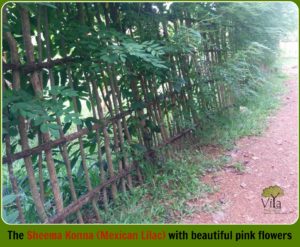
They have bright pink to lilac colour flowers that is tinged with a shade of white.
The tree is used in many tropical and sub-tropical countries for various purposes such as live natural fencing, fodder, firewood, green manure and rat poison for its medicinal and anti-repellant properties. This tree can easily be propagated through the bark.
Hibiscus
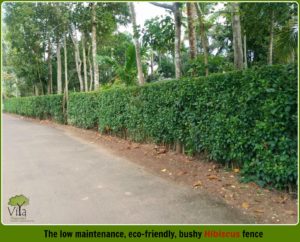
It is bushy in nature and when landscaped along with Sheema konna makes the fence thick and gives privacy.
Hibiscus flowers can be used to flavor tea and has several health benefits. The flowers attract butterflies and humming birds creating a tranquil atmosphere at your backyard.
Its leaves are natural shampoo and a gentle massage on your scalp and hair with a mixture of fresh hibiscus flowers and henna leaves will leave your hair soft and strong and revitalized.
Hibiscus plants require very low maintenance, thereby making it a highly sustainable eco friendly option.
Karingotta (Niepa bark tree)
Karingotta is an evergreen tree that can grow upto 10 meters in height and can be planted on borders at regular intervals to provide stability and canopy on the fences. They have large leaves and has a lot of medicinal uses.
Its branches are cut every year and used to pack the fences wherever there is a gap. In Kerala, traditional lime constructions uses Karingotta leaves to pack the gaps between the wood and the lime plasters.
Its leaf has a great ability to fight termites thereby making the fence long lasting. This tree is very strong and was used in borders as wind breakers for the crops in olden days. Karingotta also has several antifungal properties and can be used to treat fungal infection of your walls naturally. Read more about it here.
Thodali
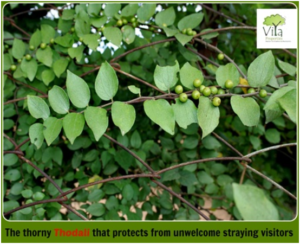
It acts as a strong barrier from even stray animals like cows thereby protecting the fence from cattle and other livestock.
It also has fruits that are edible when ripe.
Like the other options discussed here Thodali also does not need any maintenance to grow.
Kalli mullu (Cactus)
Kalli mullu is the generic name for the cactus which is a member of the plant family Cactaceae. Cactus plants are classified as succulents because of the fleshy, water-storing branches. Cacti are drought tolerant and survive well during warm, dry periods, making them an easy-to-care-for landscape plant.
Growing cacti plants near a fence has both ornamental and functional purposes. Also, they can be grown near the fences to supplement the protection provided by the fence.
The sharp spines of cacti provide an added layer of defense against unwelcome intruders such as burglars, neighborhood pranksters or burrowing wildlife.
Kaitha (screwpine)
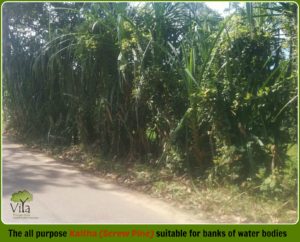
Once fully grown, the screwpine becomes abode for a lot of insects, birds and reptiles. It provides a thick protective cover and its thorny leaves provides protection against stray animals.
The leaves of the plant can be used for making fabrics, mats and other handicrafts.
Propagation of the screwpine can be done very easily by cutting and planting the stem. This also helps the mother plant to grow back very fast.
Poovarasu (Indian tulip)
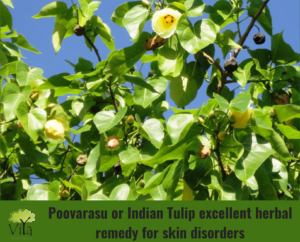
It also provides abundant leaf litter for use as mulch for improving the fertility and health of soil in sandy and coastal sites.
The tree firmly anchors sandy soils & protects them from erosion. This makes the tree a great soil improver and stabilizer and an excellent windbreak.
So why not take a break from the concrete world around you and welcome nature to your backyard?


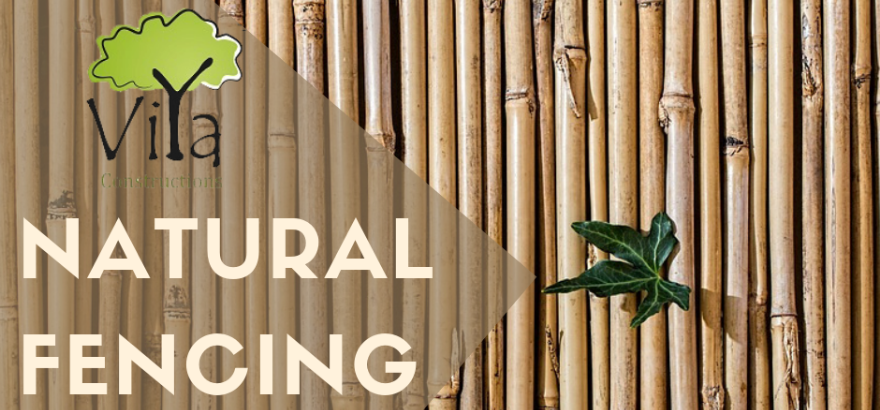
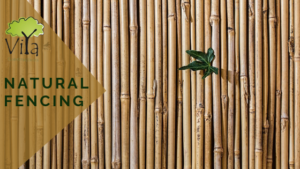
- Viya Constructions
[…] compound walls and how they are made in this post. In one of our earlier posts, we have seen about natural fencing options. Today let’s look at their concrete […]